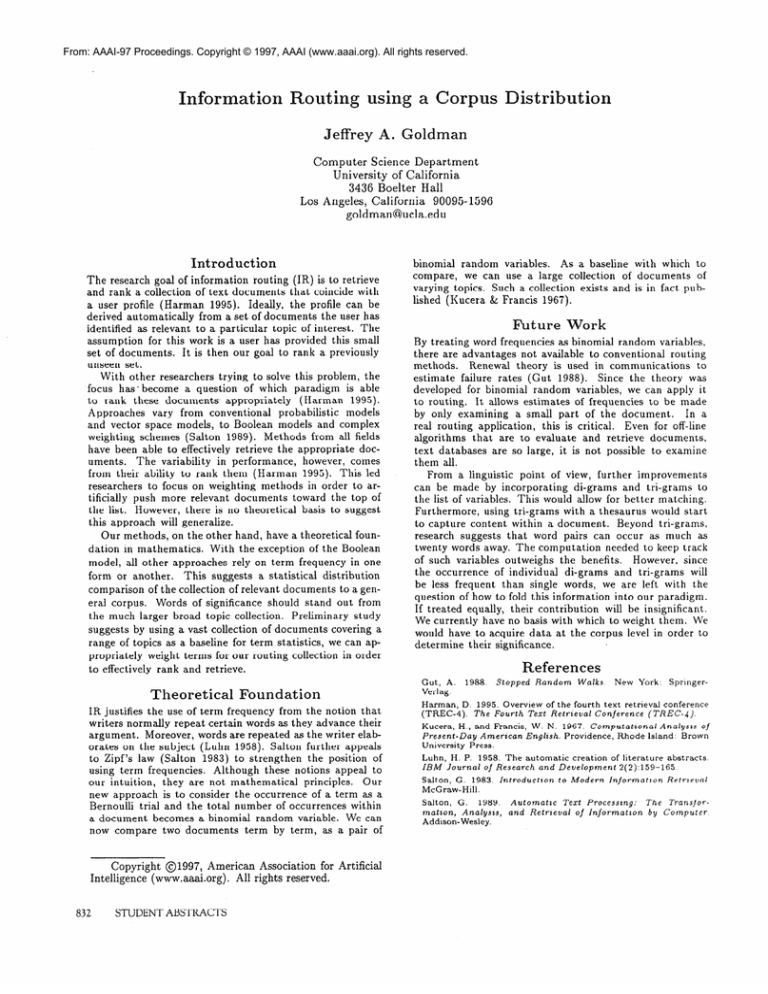
From: AAAI-97 Proceedings. Copyright © 1997, AAAI (www.aaai.org). All rights reserved.
Information
Routing
using a Corpus Distribution
Jeffrey
A.
Goldman
Computer
Science Department
University
of California
3436 Boelter Hall
Los Angeles, California
90095- 1596
goldman@ucla.edu
Introduction
The research
goal of information
routing
(IR) is to retrieve
and rank a collection
of text documents
that coincide
with
a user profile (Harman
1995).
Ideally,
the profile can be
derived
automatically
from a set of documents
the user has
identified
as relevant
to a particular
topic of interest.
The
assumption
for this work is a user has provided
this small
set of documents.
It is then our goal to rank a previously
unseen set .
With other researchers
trying
to solve this problem,
the
focus has. become
a question
of which
paradigm
is able
to rank
these
documents
appropriately
(Harman
1995).
Approaches
vary from conventional
probabilistic
models
and vector space models,
to Boolean
models
and complex
weighting
schemes
(Salton
1989).
Methods
from all fields
have been able to effectively
retrieve
the appropriate
documents.
The variability
in performance,
however,
comes
from their ability
to rank them (Harman
1995).
This led
researchers
to focus on weighting
methods
in order to artificially
push more relevant
documents
toward
the top of
the list.
However,
there is no theoretical
basis to suggest
this approach
will generalize.
Our
dation
methods,
on the other hand, have a theoretical
founin mathematics.
With the exception
of the Boolean
in one
model,
all other approaches
rely on term frequency
a statistical
distribution
form or another.
This suggests
comparison
of the collection
of relevant
documents
to a general corpus.
Words of significance
should
stand
out from
the much larger
broad topic collection.
Preliminary
study
suggests
by using a vast collection
of documents
covering
a
range of topics as a baseline
for term statistics,
we can appropriately
weight terms for our routing
collection
in order
to effectively
rank and retrieve.
Theoretical
Foundation
IR justifies
the use of term frequency
from the notion that
writers normally
repeat certain
words as they advance
their
Moreover,
words are repeated
as the writer elabargument.
orates
on the subject
(Luhn
1958). Salton
further
appeals
to Zipf’s law (Salton
1983) to strengthen
the position
of
Although
these notions
appeal
to
using term frequencies.
our intuition,
they are not mathematical
principles.
Our
new approach
is to consider
the occurrence
of a term as a
Bernoulli
trial and the total number
of occurrences
within
a document
becomes
a binomial
random
variable.
We can
now compare
two documents
term by term,
as a pair of
Copyright
01997,
American
Association
for Artificial
Intelligence
(www.aaai.org).
All rights reserved.
832
STUDENT ABSTRACTS
binomial
random
variables.
As a baseline
with which to
compare,
we can use a large collection
of documents
of
varying
topics.
Such a collection
exists and is in fact published (Kucera
& Francis
1967).
Future
Work
By treating
word frequencies
as binomial
random
variables,
there are advantages
not available
to conventional
routing
methods.
Renewal
theory
is used in communications
to
estimate
failure
rates
(Gut
1988).
Since the theory
was
developed
for binomial
random
variables,
we can apply it
to routing.
It allows estimates
of frequencies
to be made
by only examining
a small part of the document.
In a
real routing
application,
this is critical.
Even for off-line
algorithms
that
are to evaluate
and retrieve
documents,
text databases
are so large, it is not possible
to examine
them all.
From a linguistic
point of view, further
improvements
can be made by incorporating
di-grams
and tri-grams
to
the list of variables.
This would allow for better
matching.
Furthermore,
using tri-grams
with a thesaurus
would start
to capture
content
within
a document.
Beyond
tri-grams,
research
suggests
that
word pairs can occur
as much as
twenty
words away. The computation
needed to keep track
of such variables
outweighs
the benefits.
However,
since
the occurrence
of individual
di-grams
and tri-grams
will
be less frequent
than single
words,
we are left with the
question
of how to fold this information
into our paradigm.
If treated
equally,
their contribution
will be insignificant.
We currently
have no basis with which to weight them.
We
would have to acquire
data at the corpus
level in order to
determine
their significance.
References
Gut,
A.
Verlag.
Harman,
(TREC-4).
1988
D
Stopped
Salton,
G.
McGraw-Hill
Walks
New
York
Spnnger-
1995. Overview
of the fourth
text retrieval
conference
The
Fourth
Text
Retrzeual
Conference
(TREC-4)
Kucera,
H., and Francis,
Present-Day
Amerzcan
University
Press
Luhn,
H. P.
IBM
Journal
Random
W. N
Engltsh.
1967.
Computatzonal
Providence,
Rhode
1958.
The automatic
creation
of Research
and Development
1983
Salton,
G.
1989
matzon,
Analysts,
Addison-Wesley.
Introductzon
to Modern
of
Analyszs
of
Island
Brown
literature
abstracts
Z(2) 159-165
Informatton
Automatzc
Text
Processzng:
and
Retrzeval
of Informatton
Retraeval
The
by
TransforComputer





